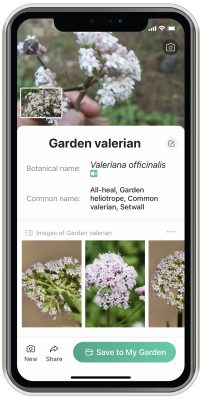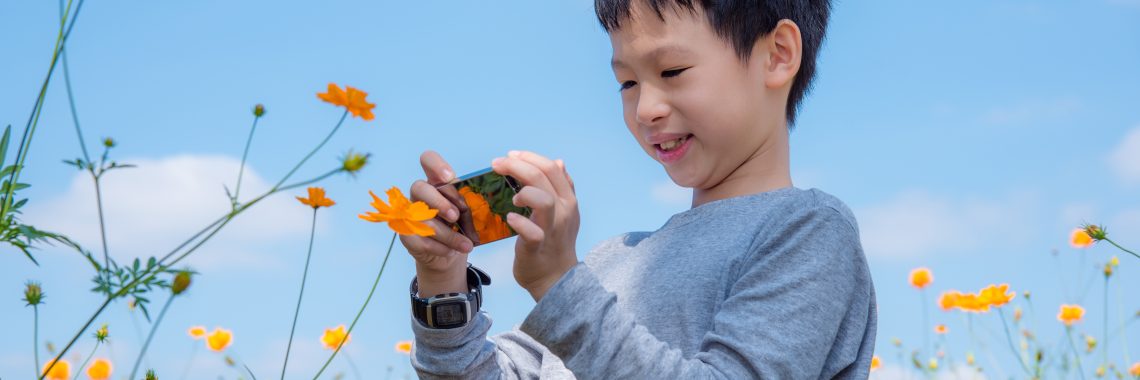Phone, wallet, keys—the three things we check before walking out the door for the day. A mere six ounces of technology millions of times more powerful than the first computer is regularly at our fingertips in the form of a smartphone. Not surprisingly, there are multiple smartphone apps that can assist with plant name discovery.
Plant identification apps can range in relevance depending on the user’s end goal, which might include management, personal enjoyment, class assignments, or landscape design. This article highlights the advantages and disadvantages of popular apps available on iOS and Android.
PlantNet
How it works: Take and upload a photo. The app identifies the photo by leaves, flowers, fruit, bark, and growth habit; the user chooses the result that most resembles the photo.
What to be wary of: This app focuses more on wild (non-cultivated) plants. With a database of only 8,000 plants, species unique to the Rocky Mountain region might not be properly identified.
Bonus: This app is free and has a web-based version. It also provides links to factsheets to learn more.
PlantSnap
How it works: As with PlantNet, the user takes and uploads a photo.
What to be wary of: The free version allows only 25 image uploads per day and contains ads; users must create an account even for the free version.
Bonus: PlantSnap’s database includes more than 600,000 different species, including plants, trees, mushrooms, houseplants, and herbs; in partnership with trees.org, PlantSnap plants new trees when app users share photos.
LeafSnap
How it works: This app is described as a combination of PlantNet and PlantSnap.
What to be wary of: The free version contains ads (but does not limit other capabilities).
Bonus: LeafSnap can be used to identify trees as well as various plants and flowers.
iNaturalist
How it works: This app offers different identification methods depending on level of interest; to determine the name of an unknown plant, other users will directly suggest identification.
What to be wary of: Users must create a “new observation” each time they want to identify a specimen.
Bonus: This app allows for user feedback that can be used to identify both plants and animals.

PictureThis
How it works: PictureThis is similar to PlantNet.
What to be wary of: This app is mainly utilized for cultivated plants and is not ideal for identifying wild plants.
Bonus: The app offers links to tips about plant care, fertilization, and weed control, as well as watering reminders.
Wyoming Wildflowers
How it works: The user selects location, month, elevation, plant type, flower color, petal and leaf arrangement, and habitat of the observed plant (categories can be left blank to increase possible matches). Photos of plants matching the criteria entered are shown in more detail.
What to be wary of: This app is most helpful for users with some knowledge of plant structure and the database is fairly limited.
Bonus: The app considers location within Wyoming and month of observation. Wyoming is a unique environment and most apps identify plants based on characteristics tailored for other regions, such as the Midwest. For example, a watermark on a leaf may be present in environmental conditions found in Ohio but is not seen in an arid environment such as Wyoming.
Other noteworthy apps
General plant identification: Google Lens, Seek, NatureID, PlantIn
Weed identification: Savvy Weed ID (The Savvy Farmer Inc.), Weed ID (BASF), ID Weeds (University of Missouri)
Which is best?
With so many options, it’s natural to ask, “Which is best?” Dr. Erin Hill, a weed scientist at Michigan State University, reviewed several apps to answer that question. (Check out her study at bit.ly/canr-msu-plant-id-apps.) Teams of students photographed dozens of plants and compared each app’s identification of each plant.
The review included broadleaf ornamentals; flowering and vegetative weeds; grasses; seedling weed species; and other common agricultural and turf weeds. Overall, the percentage of plants correctly identified ranged from 11 to 67. Partially correct identifications ranged from 25 to 80 percent. Grassy weeds and plants were the most difficult to identify. PictureThis identified 67 percent of the 130 plants under review, the highest of any app included.
Even though these numbers may not inspire confidence in plant identification apps, users can still find them helpful and relevant. All technology comes with limitations.
Tips and tricks
Botanical knowledge, including familiarity with leaf shape, flower arrangement, and seed structure, is just as helpful when utilizing apps as when identifying plants from books or in the field.
Plants may have several unique characteristics that can aid in correct identification; however, if the plant is unknown, those unique characteristics are also likely unknown. To illustrate, leafy spurge contains heart-shaped, bright yellow-green bracts; milky sap throughout the plant; and pink nodules on the roots. These distinct aspects may be overlooked since a typical visual observation does not include looking at the roots, cutting into the plant, or noting the shape or color of bracts.
Taking pictures from multiple angles of multiple plant parts (seeds, leaves, stem, and flowers) will assist when comparing the unidentified plant with suggestions from an app. Strategies to keep in mind when using apps for plant identification include limiting background interference and taking note of time of year, light quality, other plants in the area, and habitat.
Smartphone apps can be a great place to start in identifying unknown plants. However, it is important to verify with other sources. Users have found success when using the same image across multiple apps and verifying with books, reputable social media sources, or other resources.
Users can also seek out advice from University of Wyoming Extension offices, Weed and Pest district offices, UW Extension Master Gardeners, or local plant societies.
While summer is ideal for less screen time, consider making an exception to explore plant identification apps. Have fun!
Author: Jenna Meeks is an assistant research scientist for the University of Wyoming Department of Plant Sciences and can be reached at (307) 532-2436 or jmeeks8@uwyo.edu. Her favorite plant identification app is Wyoming Wildflowers.
Originally published in the Summer 2022 issue of Barnyards & Backyards magazine. Download the article as a PDF here.





